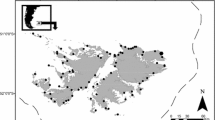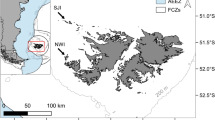Abstract
The massive expansion in breeding numbers and range of the northern fulmar Fulmarus glacialis over the last two centuries is generally attributed to an increased availability of fish offal and discarded fishes from commercial fisheries. This implies that discards should be a major component in fulmar diets in the more recently colonised areas in the south of their range. This paper examines the contemporary diet of the northern fulmar at three major breeding sites, Fair Isle (Shetland, UK), Iceland and Disko Fjord (western Greenland). At Fair Isle, 89% of regurgitates contained fishes, with sandeels (Ammodytidae) recorded in 37%; 32% contained crustaceans (mainly decapods); 8% contained squid. There was also a temporal trend; sandeels declining and crustaceans increasing in the diet from July to August. In Iceland, fishes were also the main prey (47 to 93% of wet mass), with sandeels common in the south and west, and capelin (Mallotus villosus) in the north and east. Other fish species were mainly discards, and together with discarded decapods and fish offal formed 5 to 72% of the diet, depending on the sector. Euphausiids, amphipods and copepods constituted 3 to 13% of the diet. At Disko, 39% of samples contained fishes, 64% contained crustaceans (mainly amphipods), 22% contained squid, and 16% contained pteropods. There was a clear temporal trend, with the bulk of the samples made up of crustaceans in mid-June, capelin from late June to late July, and crustaceans and pteropods from late July to late August. An extensive review of published studies was also carried out. The general pattern was for birds in more southerly populations to consume more discarded fishes, fish offal and benthic invertebrates. However, a considerable proportion of their diet also consisted of juvenile gadids, sandeels, capelin and pelagic zooplankton, which fulmars catch for themselves, and we suggest that breeding adults in the south are less dependent on fishing waste than is generally assumed.
Similar content being viewed by others
Author information
Authors and Affiliations
Additional information
Received: 25 September 1998 / Accepted: 7 May 1999
Rights and permissions
About this article
Cite this article
Phillips, R., Petersen, M., Lilliendahl, K. et al. Diet of the northern fulmar Fulmarus glacialis: reliance on commercial fisheries?. Marine Biology 135, 159–170 (1999). https://doi.org/10.1007/s002270050613
Issue Date:
DOI: https://doi.org/10.1007/s002270050613




